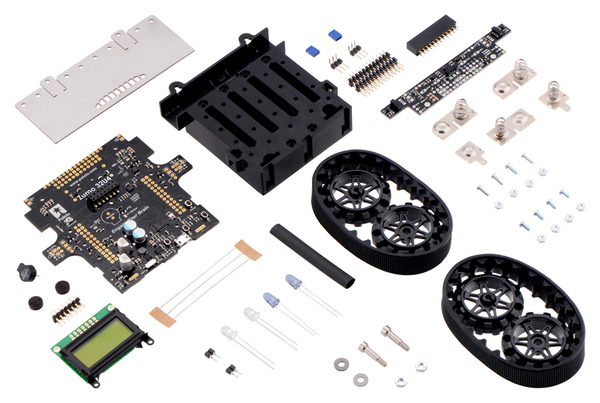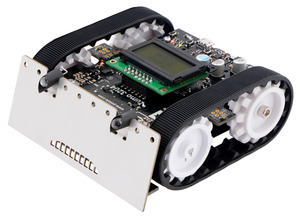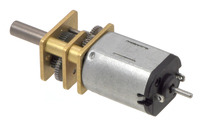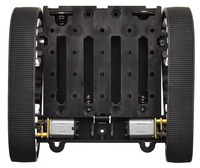The Pololu Zumo 32U4 robot is a versatile tracked robot based on the Arduino-compatible ATmega32U4 MCU, and this kit contains most of the parts you need to build one—all you need to add are a pair of
micro metal gearmotors and four
AA batteries. It includes integrated dual motor drivers, an LCD, quadrature encoders, line sensors, side and front proximity sensors, and a full IMU. The assembled robot is less than 10cm×10cm—small enough to qualify for Mini Sumo. This product is a
kit; assembly (including soldering) is required.
Note: This product is a kit; assembly (including soldering) is required. Motors and batteries are sold separately. A USB A to Micro-B cable (not included) is required for programming.
New sprockets! As of April 10, 2015, we are transitioning to new black, spoked sprockets in place of the original white ones. If you ordered a Zumo 32U4 kit before this change and want the newer sprockets, please contact us with your original order number.
|
 |
| Assembled Zumo 32U4 robot, front view. |
 |
| Assembled Zumo 32U4 robot, side view. |
 |
| Assembled Zumo 32U4 robot, back view. |
Overview
The Zumo 32U4 is a highly integrated, user-programmable and customizable robot. When assembled, the low-profile tracked robot measures less than 10 cm on each side and weighs approximately 275g with batteries (170g without), so it is both small enough and light enough to qualify for Mini-Sumo competitions, but its versatility makes it capable of much more than just robot sumo battles.
At the heart of the Zumo 32U4 is an Atmel ATmega32U4 AVR microcontroller, and like our A-Star 32U4 programmable controllers, the Zumo 32U4 features a USB interface and ships preloaded with an Arduino-compatible bootloader. A software add-on is available that makes it easy to program the robot from the Arduino environment, and we have Arduino libraries and example sketches to help get you started. For advanced users who want to customize or enhance their robots with additional peripherals, the robot’s power rails and microcontroller’s I/O lines can be accessed via 0.1″-spaced through-holes along the sides and front of the main board.
The Zumo 32U4 features two H-bridge motor drivers and a variety of integrated sensors, including a pair of quadrature encoders for closed-loop motor control, a complete inertial measurement unit (3-axis accelerometer, gyro, and magnetometer), five downward-facing reflectance sensors for line-following or edge-detection, and front- and side-facing proximity sensors for obstacle detection and ranging. Three on-board pushbuttons offer a convenient interface for user input, and an LCD, buzzer, and indicator LEDs allow the robot to provide feedback.
Kit contents
 |
| Contents of the Zumo 32U4 robot kit. |
With the exception of motors, batteries, and a USB A to Micro-B cable, this kit contains everything necessary to build and operate a Zumo 32U4 robot:
 |
| Assembled Zumo 32U4 robot. |
- Zumo chassis kit
- Zumo 32U4 main board
- Zumo 32U4 front sensor array
- stainless steel Zumo 32U4 blade
- 8×2 character LCD
- two magnetic encoder discs (the encoder sensors are integrated into the main board)
- IR LEDs (proximity sensor emitters; the detectors are integrated into the front sensor array)
- through-hole buzzer
- assorted hardware and connectors
See the Zumo 32U4 robot user’s guide for detailed assembly instructions.
Motors (not included)
 |
| Micro metal gearmotor with extended motor shaft. |
 |
The Zumo chassis uses two micro metal gearmotors, one for each tread. The ideal motors for your robot depend on your desired torque, speed, and current draw, so
motors are not included with the chassis. We generally recommend using HP versions of our micro metal gearmotors since the tracks require a decent amount of torque to move effectively; higher gear ratios of the non-HP motors might work if you want lower current draw, but they will be slower and offer less control. Specifically, we recommend the 50:1, 75:1, or 100:1 HP motors for use with this chassis. Additionally, be sure to get a version with extended motor shafts if you want to be able to use the Zumo 32U4’s encoders. The following table summarizes the key specifications of these three gearmotors. The first four columns are specifications of the motors themselves, while the last column is the measured top speed of a Zumo chassis loaded to a weight of 500g and driven with these motors. Note that the specifications are for 6V operation, which is approximately the voltage you would get with four alkaline batteries; four NiMH AA cells will typically provide less than 5V.
Micro Metal
Gearmotor |
Free-Run Speed
@ 6V |
Stall Torque
@ 6V |
Stall Current
@ 6V |
Top Zumo Speed
@ 6V and 500g |
| 100:1 HP |
320 RPM |
30 oz·in |
1600 mA |
20 in/s |
(50 cm/s) |
| 75:1 HP |
400 RPM |
22 oz·in |
1600 mA |
25 in/s |
(65 cm/s) |
| 50:1 HP |
625 RPM |
15 oz·in |
1600 mA |
40 in/s |
(100 cm/s) |
Batteries (not included)
The Zumo 32U4 robot runs off of four AA batteries. It works with both alkaline and NiMH batteries, though we recommend using rechargeable AA NiMH cells.
Optional accessories
- Even more sensors
- Connectors (headers, jumper wires, etc) for adding those sensors or other peripherals
- Tools (soldering iron, diagonal cutters, pliers, screwdrivers, etc) to help with kit assembly
Comparison with the Zumo robot kit for Arduino (with Zumo Shield)
Our older Zumo robot for Arduino, built with a Zumo Shield, is another Arduino-compatible robotic platform based on the Zumo chassis. The Zumo Shield mounts to the Zumo chassis and features motor drivers and various sensors, but it does not have an integrated microcontroller; rather, it is designed to interface with boards that have a standard Arduino form factor, like an Arduino Uno, Arduino Leonardo, or A-Star 32U4 Prime, and these boards serve as the main controller for the robot.
 |
| A Zumo 32U4 robot (left) and a Zumo robot for Arduino with an A-Star 32U4 Prime LV (right). |
By contrast, the Zumo 32U4 includes an on-board ATmega32U4 microcontroller (the same one used in the Leonardo and A-Star 32U4 boards), combining the functions of the Zumo Shield and the separate Arduino controller into a single, compact board that is just as easy to program as a standard Arduino or A-Star thanks to its USB interface and preloaded Arduino-compatible bootloader. The Zumo 32U4 retains all the features of the Zumo shield (e.g. dual motor drivers, inertial sensors, and buzzer) while adding many new features, including dual quadrature encoders, proximity sensors, an LCD, and two extra user pushbuttons.
Some of the pin mappings and software libraries differ between the Zumo 32U4 and Zumo robot for Arduino, so programs written for one robot generally need to be modified to work on the other.
Documentation and other information
File downloads
- Pololu A-Star Software and Drivers (version 1.4.0) (281k zip)
- This download contains the Windows drivers for the A-Star, the add-on for the Arduino IDE, the source code and compiled version of the bootloader, the AStar32U4Prime library, the Zumo32U4 library, and a configuration file that some Linux users will need.
- Zumo 32U4 pinout diagram (536k pdf)
- Printable pinout diagram of the Zumo 32U4 main board.
- Zumo 32U4 schematic diagram (1MB pdf)
- Printable schematic diagram of the Zumo 32U4 robot.
- Zumo 32U4 robot 3D model (17MB pdf)
- Rotatable 3D model of an assembled Zumo 32U4 robot (Note: this file might not work properly with all pdf viewers.)
- 3D-printable IR LED holder for the Zumo 32U4 robot (65k stl)
-
For those with access to a 3D printer, this part provides a more robust way to anchor and shield the Zumo 32U4 robot’s front-facing, through-hole IR LED emitters. It mounts to the Zumo’s blade and serves as alternative to the heat shrink shielding included with the Zumo 32U4 robot kit.
 |
| 3D-printable IR LED holder for the Zumo 32U4 robot, front view. |
|
 |
| 3D-printable IR LED holder for the Zumo 32U4 robot, back view. |
|
- Texas Instruments DRV8837/DRV8838 motor driver datasheet (1MB pdf)
- LSM303D datasheet (1MB pdf)
- Datasheet for the ST LSM303D 3D accelerometer and 3D magnetometer module.
- L3GD20H datasheet (3MB pdf)
- Datasheet for the ST L3GD20H three-axis digital-output gyroscope.
- Datasheet for the Sharp GP2S60 compact reflective photointerrupter (164k pdf)
- Datasheet for the sensor used on the QTR-3RC and QTR-3A Reflectance Sensor Arrays, the Zumo 32U4 robot front sensor array, and the Optical Encoders for micro metal gearmotors.
- Vishay TSSP77038 IR receiver module datasheet (268k pdf)
- TPS2113A datasheet (1MB pdf)
- Datasheet for the Texas Instruments TPS2113A autoswitching power mux.
No recommended products at the moment.
No recommended products at the moment.